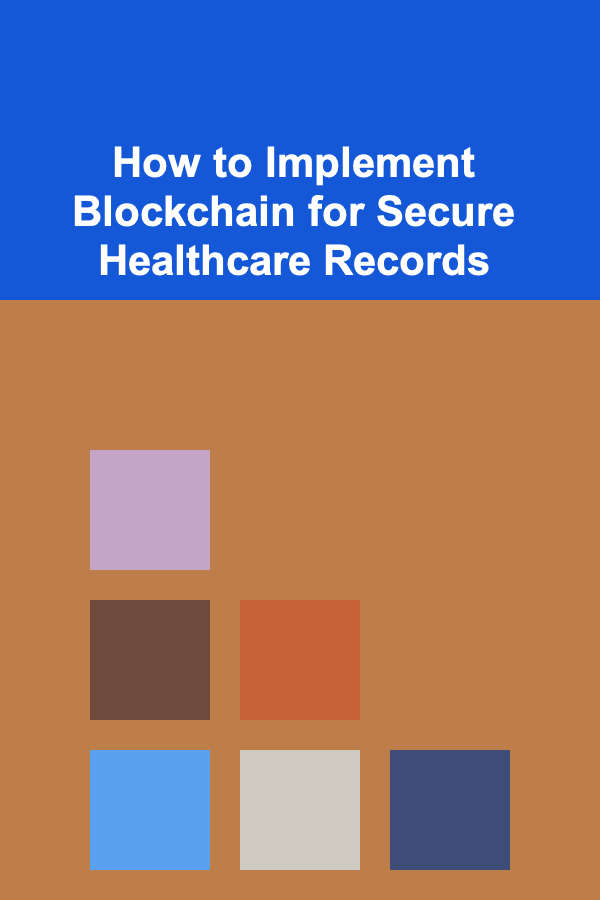
How to Implement Blockchain for Secure Healthcare Records
ebook include PDF & Audio bundle (Micro Guide)
$12.99$8.99
Limited Time Offer! Order within the next:

Blockchain technology has been heralded as a revolutionary force in a variety of industries, ranging from finance to supply chain management. One of the most promising areas where blockchain can make a significant impact is healthcare. In this digital age, securing sensitive data, such as healthcare records, is crucial. A breach in healthcare data security can have dire consequences, including identity theft, loss of patient trust, and even harm to patients' health. Blockchain, with its unique characteristics of decentralization, immutability, and transparency, offers a solution to these challenges. This article explores how blockchain can be implemented for secure healthcare records, examining the potential benefits, challenges, and steps required for successful adoption.
Understanding Blockchain Technology
Blockchain is a decentralized, distributed ledger that records transactions across many computers in such a way that the registered transactions cannot be altered retroactively. This technology was originally designed for Bitcoin, but its potential for other applications has been widely recognized. Blockchain uses cryptographic algorithms to ensure the integrity and security of data, making it a suitable option for industries like healthcare where data integrity and security are paramount.
In the context of healthcare records, blockchain offers several advantages:
- Security: Blockchain's decentralized nature ensures that no single entity has control over the data. This makes it more resistant to hacking, as a breach would require the attacker to compromise multiple nodes simultaneously.
- Immutability: Once data is recorded on a blockchain, it cannot be changed. This ensures that healthcare records are permanent and tamper-proof.
- Transparency: Blockchain provides transparency, allowing all parties involved in healthcare to have access to a verified history of records, ensuring accountability and trust.
- Interoperability: Blockchain can allow for better interoperability between different healthcare systems and institutions, facilitating smoother data sharing while maintaining privacy.
Given these characteristics, blockchain holds great promise in improving the way healthcare data is stored, shared, and protected.
Key Challenges in Healthcare Data Security
Before diving into how blockchain can be implemented in healthcare, it's essential to understand the primary challenges in securing healthcare records:
1. Data Privacy Concerns
Healthcare records contain sensitive personal information, such as medical history, diagnoses, and treatments. Ensuring that this data is kept private and only accessible to authorized individuals is a significant challenge. Traditional centralized databases, while convenient, are vulnerable to hacking and data breaches. Blockchain's encryption and decentralized structure could provide a solution to this concern, ensuring that only authorized parties have access to sensitive healthcare data.
2. Fragmented Healthcare Systems
One of the significant problems in healthcare is the fragmentation of data. Patient records are often spread across different hospitals, clinics, and healthcare providers, and there is no unified system to access all of this information in one place. This lack of interoperability can lead to inefficiencies, delayed diagnoses, and increased risk of errors. Blockchain could help resolve this issue by providing a decentralized platform that enables secure data sharing across different systems while ensuring that patient privacy is maintained.
3. Lack of Trust and Transparency
In the traditional healthcare system, trust is often placed in centralized institutions such as hospitals and insurance companies. However, this system has been criticized for its lack of transparency and accountability. Blockchain could increase trust in the system by providing a transparent and auditable history of patient data, allowing patients and healthcare providers to verify information and track access to medical records.
4. Compliance with Regulations
Healthcare systems are subject to strict regulations, including the Health Insurance Portability and Accountability Act (HIPAA) in the United States. These regulations mandate that patient data be kept confidential and secure. Any solution that handles healthcare data must ensure compliance with such regulations. Blockchain's encryption and access control mechanisms could help ensure compliance while enhancing data security.
How Blockchain Can Be Implemented for Secure Healthcare Records
Implementing blockchain for secure healthcare records involves several key steps. While the concept is straightforward, the process requires careful planning and execution to ensure that the implementation is effective and compliant with regulations. Below are the key steps to successfully implement blockchain in healthcare for securing records.
1. Design a Blockchain Network
The first step in implementing blockchain for healthcare records is to design the blockchain network. There are two main types of blockchain networks to consider:
- Public Blockchain: A public blockchain is open to anyone and does not require permission to join. It is decentralized and provides a high level of transparency. However, public blockchains may have scalability and privacy concerns.
- Private Blockchain: A private blockchain is restricted to a specific group of participants, such as hospitals, clinics, and healthcare providers. It offers greater privacy and scalability but sacrifices some of the transparency of public blockchains.
For healthcare records, a private or consortium blockchain is likely the best choice. This would allow multiple trusted healthcare providers to share and access records while maintaining control over who can access the data.
2. Create a Secure Data Structure
Blockchain ensures data integrity through its cryptographic hash functions. However, when it comes to healthcare records, it is important to design a secure data structure that both protects patient privacy and ensures data is accessible when needed.
One approach is to store a cryptographic hash of the healthcare data on the blockchain, while the actual data remains stored in a secure off-chain database. The blockchain would store a pointer to the off-chain data, such as an encrypted identifier. This would allow healthcare providers to verify that the data hasn't been tampered with, while still ensuring that sensitive data is not exposed on the blockchain itself.
3. Implement Access Control and Authorization
One of the key components of implementing blockchain in healthcare is ensuring that only authorized individuals can access patient data. Blockchain allows for fine-grained control over access to information, using features such as smart contracts and identity management.
- Smart Contracts: Smart contracts are self-executing contracts with the terms of the agreement directly written into code. In the context of healthcare, smart contracts can be used to automate access control, ensuring that only authorized parties can access certain medical records based on predefined rules.
- Identity Management: Identity management systems, such as decentralized identifiers (DIDs), can be integrated with blockchain to authenticate users and control access to healthcare records. Patients could control their own access permissions, giving them the ability to grant or revoke access to their records.
4. Ensure Compliance with Regulations
Healthcare organizations must comply with various regulations, including data privacy laws such as HIPAA in the U.S. and the General Data Protection Regulation (GDPR) in the EU. Implementing blockchain for healthcare records must ensure that these regulations are met.
Blockchain's inherent features, such as data immutability and encryption, can help ensure compliance. However, careful consideration must be given to how data is stored on the blockchain (e.g., whether personal data is stored directly on the chain or off-chain) to ensure that it meets regulatory requirements.
5. Interoperability with Existing Systems
The healthcare industry relies on a wide range of electronic health record (EHR) systems, many of which are not interoperable. Blockchain can help improve interoperability by providing a secure and standardized way for different healthcare providers to share data.
Integrating blockchain with existing EHR systems will require the development of APIs or middleware that can facilitate data exchange between the blockchain and traditional healthcare systems. These solutions must ensure that data is transferred securely, and that privacy is maintained throughout the process.
6. Ensure Scalability and Performance
Healthcare data is vast, and as the industry continues to digitize, the amount of data generated will only increase. For blockchain to be effective in healthcare, it must be able to scale and handle large amounts of data without compromising performance.
Solutions such as layer-2 scaling protocols or sharding can be explored to improve the scalability of the blockchain. Additionally, blockchain networks should be optimized to process transactions quickly to ensure that healthcare providers can access patient records in real-time when needed.
7. Patient Consent and Control
One of the significant benefits of blockchain in healthcare is the potential for patients to have more control over their own data. Through blockchain, patients can grant or deny access to their medical records, providing greater transparency and control.
A patient consent management system could be integrated into the blockchain platform, allowing patients to digitally sign consent forms, manage access to their data, and track who has viewed or modified their records. This would not only enhance patient privacy but also increase trust in the healthcare system.
Potential Benefits of Blockchain in Healthcare Records
The implementation of blockchain for secure healthcare records offers several benefits, including:
1. Enhanced Security
Blockchain's cryptographic nature ensures that healthcare records are tamper-proof and secure. By storing data on a decentralized network, the system is less vulnerable to hacking and data breaches. Only authorized parties can access the data, and the use of encryption further protects sensitive information.
2. Improved Interoperability
Blockchain can facilitate the secure exchange of data between different healthcare providers, enabling better collaboration and ensuring that medical records are available when and where they are needed. This can improve patient outcomes by ensuring that healthcare providers have access to complete and accurate information.
3. Increased Trust and Transparency
Blockchain provides a transparent and auditable record of all transactions. This increases trust between patients and healthcare providers, as well as between healthcare institutions. Patients can see who has accessed their records and when, and they can track changes to their data over time.
4. Cost Reduction
By reducing the need for intermediaries and eliminating data silos, blockchain can lower administrative costs in the healthcare sector. Additionally, blockchain could streamline billing and insurance processes, reducing fraud and simplifying claims processing.
Challenges to Overcome
While the potential benefits of blockchain in healthcare are significant, several challenges remain:
- Adoption and Integration: Integrating blockchain with existing healthcare systems and getting buy-in from healthcare providers can be a significant hurdle.
- Regulatory Compliance: Ensuring that blockchain implementations comply with privacy laws and healthcare regulations can be complex.
- Scalability: Blockchain must be able to handle the massive volume of data generated by the healthcare industry, without sacrificing performance or security.
- Patient Education: Patients must be educated about how blockchain works and how they can control access to their data.
Conclusion
Implementing blockchain for secure healthcare records has the potential to revolutionize the way healthcare data is managed and shared. By providing enhanced security, improving interoperability, increasing transparency, and empowering patients with control over their data, blockchain can address many of the challenges faced by the healthcare industry today. However, successful implementation will require careful planning, regulatory compliance, and collaboration among stakeholders. As the healthcare industry continues to embrace digital transformation, blockchain stands as a promising solution for ensuring the security and privacy of healthcare records.

How to Keep Your House Clean in a Busy Household
Read More
How to Manage Multiple Rental Properties Without Overwhelm
Read More
How to Use Analytics to Optimize Advertising Designs
Read More
How To Develop a Yoga Practice for Kids
Read More
Understanding the Philosophy of Politics: A Deep Dive
Read More
The Art and Science of Perfect Caramel Sauce
Read MoreOther Products

How to Keep Your House Clean in a Busy Household
Read More
How to Manage Multiple Rental Properties Without Overwhelm
Read More
How to Use Analytics to Optimize Advertising Designs
Read More
How To Develop a Yoga Practice for Kids
Read More
Understanding the Philosophy of Politics: A Deep Dive
Read More